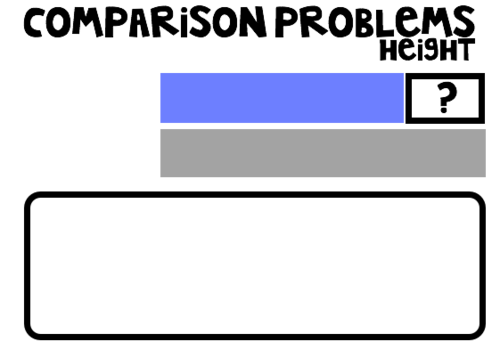







**This resource does not include an input to deliver to your class and it is NOT a lesson plan. It is a resource to support a specific area in the maths curriculum: using bar models to represent comparison problems.
I love using bar models to teach comparison problems! Many children confuse 'difference'; with addition instead of subtraction and do not realise how many more/less is a way of comparing two different amounts. These questions are often asked in context with liquid, height, money, etc.
Last year, I had my children come up with an example of a comparison problem and write it in the empty box provided. (For example: A football costs £12.45, but a pair of shin pads costs £7.00. What is the difference in their price?) Then, they had to write the item with the larger price next to the large bar model, and the name of the item with the lower price next to the small bar model. They worked out to solve the answer in their books and rotated around the room to solve other children's problems.
You can also give children the problems you want them to solve and ask them to model it using the bar model cards. They can then use the empty space to show their working out.
This is a great way to show children comparison problems through a variety of contexts and prepare them for making connections across different maths domains and problem-solving.
*INCLUDED is a black and white template of the bars for you to adapt as necessary*
I love using bar models to teach comparison problems! Many children confuse 'difference'; with addition instead of subtraction and do not realise how many more/less is a way of comparing two different amounts. These questions are often asked in context with liquid, height, money, etc.
Last year, I had my children come up with an example of a comparison problem and write it in the empty box provided. (For example: A football costs £12.45, but a pair of shin pads costs £7.00. What is the difference in their price?) Then, they had to write the item with the larger price next to the large bar model, and the name of the item with the lower price next to the small bar model. They worked out to solve the answer in their books and rotated around the room to solve other children's problems.
You can also give children the problems you want them to solve and ask them to model it using the bar model cards. They can then use the empty space to show their working out.
This is a great way to show children comparison problems through a variety of contexts and prepare them for making connections across different maths domains and problem-solving.
*INCLUDED is a black and white template of the bars for you to adapt as necessary*
Something went wrong, please try again later.
Report this resourceto let us know if it violates our terms and conditions.
Our customer service team will review your report and will be in touch.
£0.00